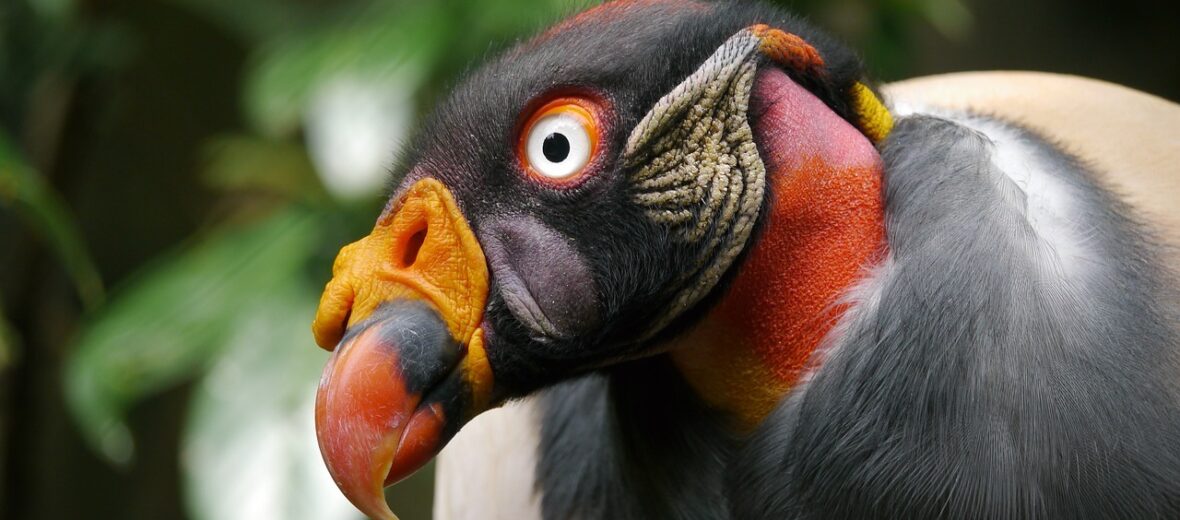
When the king vulture arrives at the scene, other birds will literally step aside and let the king eat. Considered to be the largest and arguably one of the prettiest of the vulture species, the brilliant coloration on their head is actually skin. See, vultures tend to not have any feathers around their face, as it can get pretty messy eating carrion (dead animals). Feathers would just get in the way, become messy, and attract disease. While they are listed as Least Concern by the IUCN, their numbers are decreasing. There are only an estimated 6,700 remaining in the wild, to date. This is due, in part to habitat destruction and possible accidental poisoning.
First the Stats…
Scientific name: Sarcoramphus papa
Weight: Up to 9 lbs.
Length: Up to 32 inches
Wingspan: Up to 8.9 feet
Lifespan: Up to 30 years
Now on to the Facts!
1.) Unlike many other New World vultures, these critters lack eyelashes.
2.) Even though they have strong claws and a powerful beak, these birds actually depend on other birds to begin the process of tearing into a carcass first.
3.) They can be found south of Mexico and throughout Central and South America to northern Argentina.
4.) While they prefer tropical forests, they can also be found in savannahs and grasslands as well.
5.) Like other vultures, the king vulture does not migrate.
But wait, there’s more on the king vulture!
6.) King vultures prefer to gather in small family units, rather than in flocks.
7.) A grouping of these vultures can come together, during a feeding. Larger groups of king vultures are called a committee, a kettle, or a wake.
Did you know…?
The king vulture doesn’t have a voice box (a syrinx) nor the muscles needed to make it work, even if they did have one. They can still make a quiet, low croak. During the breeding season, they will sometimes sound a warning when a creature nears their nesting site.
8.) Just like other vultures and condors, they are diurnal (active during the day).
9.) Breeding takes place during the dry season and courtship entails an elaborate display in which a series of wheezing and hissing sounds are made, and these are accompanied by pacing around in circles while flapping their wings.
10.) Monogamy (mating for life) has typically only been witnessed in captivity.
But wait, there’s still more on the king vulture!
11.) Their scientific name ‘Sarcoramphus papa’ (translates to “the pope’s fleshy beak”. No doubt referring to the bright orange skin on the top of their orange beak.
12.) Their nesting site leaves much to be desired and is typically nothing more than an impression made in the ground or at the base of a tree stump. They protect their nest by regurgitating rotten food all over the nest site.
Did you know…?
That fleshy little wattle that sits on the king vulture’s beak is called a caruncle. Both males and females have them. However, the wattle’s purpose continues to baffle scientists.
13.) Females lay a single egg which hatches in up to 58 days.
14.) The chicks are independent in approximately 8 months.
15.) In a process known as urohydrosis, the king vulture will attempt to cool itself via defecating (pooping) on its legs. The drying poop, catching the breezes and cools the bird down. What other bird does this? That’s right, the marabou stork.
But wait, there’s still a little more on the king vulture!
16.) Condors are the closest relatives of the vulture and only the Andean condor is larger than the king vulture.
17.) After consuming a tasty meal of dead animal flesh, they will fly to a nearby body of water to bathe.
Did you know…?
According to Mayan mythology, the king vulture often carried messages between humans and the other gods.
18.) The ancient Mayan civilization revered the King vulture, adding it their art. Even naming the bird, “Oc”.
19.) They are descendants of the Kern vulture (Sarcoramphus kernense), which lived in southwestern North America during the mid-Pliocene (Piacenzian), approximately 3.5 – 2.5 million years ago.
20.) King vultures seldom flap their wings to fly, preferring instead to use thermals to gain lift in flight. They use energy to flap their wings as little as possible.
Now a Short King Vulture Video!
Also, check out the Critter Science YouTube channel. Videos added frequently!
Want to suggest a critter for me to write about? Let me know here.



